This post originally appeared on Persephone Magazine. It is cross-posted here with editorial permission.
As a child, I watched a lot of horror movies. We were poor and could rarely afford to go to the theater to see new films. But, we could afford to take a trip to the local video rental store here and there and pick up some old movies and kettle corn. My parents often rented the cheap, B-Horror films, movies such as Monkey Shines, The Dentist, and Bloody Birthday, and we would watch them as a family in a dark room with my brother and I lying on the living room floor and my parents cuddled on the couch. We can debate about the impact that had on our young psyches; my brother used to be so terrified of the Nightmare on Elm Street 4 box cover that he would shield his eyes when it entered his field of vision. But, it took a lot to scare me then and now.
That was until 9-year-old me watched Tales from the Hood for the first time.
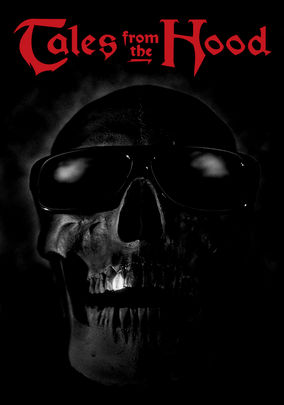 Tales from the Hood is a horror anthology film written and directed by Rusty Cundieff and produced by Spike Lee. The film follows three drug dealers stopping at a funeral to purchase a large “stack” of drugs found in an alley by mortician Mr. Simms (Clarence Williams III). Simms promises to get the men “the shit.” In fact, he promises that they’ll be “knee deep in the shit!” But, first he gives them a tour of the funeral home and tells us the stories of the untimely passing of his current customers. While this set up doesn’t differ very much from other horror anthology framing devices, the individual stories manage to be horrifying yet empowering in a way I’ve rarely seen in other horror films. Let’s explore those in more detail.
Tales from the Hood is a horror anthology film written and directed by Rusty Cundieff and produced by Spike Lee. The film follows three drug dealers stopping at a funeral to purchase a large “stack” of drugs found in an alley by mortician Mr. Simms (Clarence Williams III). Simms promises to get the men “the shit.” In fact, he promises that they’ll be “knee deep in the shit!” But, first he gives them a tour of the funeral home and tells us the stories of the untimely passing of his current customers. While this set up doesn’t differ very much from other horror anthology framing devices, the individual stories manage to be horrifying yet empowering in a way I’ve rarely seen in other horror films. Let’s explore those in more detail.
[Content warning: racism, police brutality, child abuse, domestic violence, blood, gore, gun violence]
“Rogue Cop Revelation”
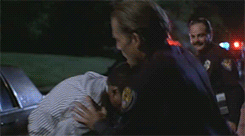 Our first story centers on Clarence, a young Black rookie cop who later becomes an unemployed and guilt-ridden alcoholic after the fall out of what should have been a routine ride along with his partner, a white officer. They respond to a call by two fellow officers, also white, who are shaking down Martin Morehouse, an important Black activist and local politician who has made it a mission to root out corruption in the police force. Angry at his interference, the officers break Morehouse’s taillight when he argues that they had no reason to stop him. When he further protests, they begin beating him. Clarence tries to intervene, but his partner dissuades him from doing so and from reporting the other officers’ misconduct. Later, the other two officers murder Morehouse and stage it as a drug overdose. Many years later, Morehouse haunts Clarence and commands Clarence to “bring them to me!” This time Clarence helps Morehouse, who exacts his revenge.
Our first story centers on Clarence, a young Black rookie cop who later becomes an unemployed and guilt-ridden alcoholic after the fall out of what should have been a routine ride along with his partner, a white officer. They respond to a call by two fellow officers, also white, who are shaking down Martin Morehouse, an important Black activist and local politician who has made it a mission to root out corruption in the police force. Angry at his interference, the officers break Morehouse’s taillight when he argues that they had no reason to stop him. When he further protests, they begin beating him. Clarence tries to intervene, but his partner dissuades him from doing so and from reporting the other officers’ misconduct. Later, the other two officers murder Morehouse and stage it as a drug overdose. Many years later, Morehouse haunts Clarence and commands Clarence to “bring them to me!” This time Clarence helps Morehouse, who exacts his revenge.
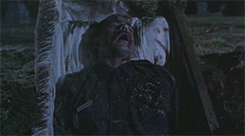 The commentary offered in this short remains as relevant today as it was in 1995. Black people and other people of color have long been victims of racially motivated state violence and extrajudicial killings. The Malcolm X Grassroots Movement recently reported that, in 2012, one Black person was killed by “police, security guards, and vigilantes” at least every 28 hours. As early as 1999, spurred by the murder of Amadou Diallo by New York City officers, Amnesty International released a report on “Race, Rights & Police Brutality” detailing instances of racially motivated police brutality and murder and the relatively low rate of prosecutions resulting in these cases. The film posits an even deeper historical connection to the lynching of Black people in the United States during and after the Reconstruction era and the murders of Black civil rights leaders as Billie Holiday’s “Strange Fruit” plays over scenes of Morehouse’s beating and interspersed with a rousing speech confronting police corruption. Furthermore, Morehouse often appears to Clarence nailed to a cross, a not-so-subtle nod to Morehouse’s position as a civil rights martyr. But, unlike the reality for most victims of police misconduct, Morehouse does see some kind of justice. These cops are not prosecuted or brought up on charges, but Morehouse makes them pay dearly for their crimes against him. Still, he remains angry at Clarence, asking him, “Where were you when I needed you, brother?” before disappearing. In the end, we’re left wondering if Clarence ever saw the deceased Morehouse or if he, in a fit of guilt and anger, avenged himself upon his former colleagues.
The commentary offered in this short remains as relevant today as it was in 1995. Black people and other people of color have long been victims of racially motivated state violence and extrajudicial killings. The Malcolm X Grassroots Movement recently reported that, in 2012, one Black person was killed by “police, security guards, and vigilantes” at least every 28 hours. As early as 1999, spurred by the murder of Amadou Diallo by New York City officers, Amnesty International released a report on “Race, Rights & Police Brutality” detailing instances of racially motivated police brutality and murder and the relatively low rate of prosecutions resulting in these cases. The film posits an even deeper historical connection to the lynching of Black people in the United States during and after the Reconstruction era and the murders of Black civil rights leaders as Billie Holiday’s “Strange Fruit” plays over scenes of Morehouse’s beating and interspersed with a rousing speech confronting police corruption. Furthermore, Morehouse often appears to Clarence nailed to a cross, a not-so-subtle nod to Morehouse’s position as a civil rights martyr. But, unlike the reality for most victims of police misconduct, Morehouse does see some kind of justice. These cops are not prosecuted or brought up on charges, but Morehouse makes them pay dearly for their crimes against him. Still, he remains angry at Clarence, asking him, “Where were you when I needed you, brother?” before disappearing. In the end, we’re left wondering if Clarence ever saw the deceased Morehouse or if he, in a fit of guilt and anger, avenged himself upon his former colleagues.
“Boys Do Get Bruised”
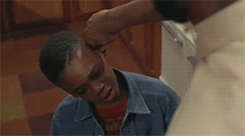 The second story in the film centers on a young Black boy named Walter. When Walter begins arriving to school with numerous bumps and bruises, his teacher becomes suspicious. Walter blames “the monster” that lives in his home and comes for him night after night. In an attempt to kill the monster, Walter creates drawings of all that he fears on the advice of a fellow classmate. He believes that if he destroys the drawings he will destroy the monster. The teacher, now more concerned than ever, visits the home to assess the situation. He soon meets Walter’s violent and abusive stepfather (portrayed by David Allen Grier in a rare non-comedic role) who assaults and attempts to murder Walter, Walter’s mother Sissy, and the teacher. But, Walter, with some help from both adults, gets the upper hand and vanquishes the monster.
The second story in the film centers on a young Black boy named Walter. When Walter begins arriving to school with numerous bumps and bruises, his teacher becomes suspicious. Walter blames “the monster” that lives in his home and comes for him night after night. In an attempt to kill the monster, Walter creates drawings of all that he fears on the advice of a fellow classmate. He believes that if he destroys the drawings he will destroy the monster. The teacher, now more concerned than ever, visits the home to assess the situation. He soon meets Walter’s violent and abusive stepfather (portrayed by David Allen Grier in a rare non-comedic role) who assaults and attempts to murder Walter, Walter’s mother Sissy, and the teacher. But, Walter, with some help from both adults, gets the upper hand and vanquishes the monster.
 According to a 2011 report by the United States government an average of four children died every day that year because of mistreatment and abuse. This, of course, only accounts for reported instances of abuse and does not account for populations that may be reluctant to report child maltreatment for varying reasons (e.g. immigrant populations, poor communities of color). The same can be said of domestic violence statistics that tell us that 1 in 3 women will confront domestic violence in her lifetime. My mother was one of those women, and my brother and I were two of those children. I still remember and am still undoing the anger, uncertainty, fear, and emotional and spiritual illness that accompanied living in a home where experiencing or witnessing violence was a fact of life. I identified with Walter who experienced those same emotions as he battled and ultimately his very own and very real monster as I’m sure millions of children do. I did not and do not think of my abusers as monsters, and I don’t expect that everyone will have the same opportunity to defeat their own. But, Walter survived, and so did I.
According to a 2011 report by the United States government an average of four children died every day that year because of mistreatment and abuse. This, of course, only accounts for reported instances of abuse and does not account for populations that may be reluctant to report child maltreatment for varying reasons (e.g. immigrant populations, poor communities of color). The same can be said of domestic violence statistics that tell us that 1 in 3 women will confront domestic violence in her lifetime. My mother was one of those women, and my brother and I were two of those children. I still remember and am still undoing the anger, uncertainty, fear, and emotional and spiritual illness that accompanied living in a home where experiencing or witnessing violence was a fact of life. I identified with Walter who experienced those same emotions as he battled and ultimately his very own and very real monster as I’m sure millions of children do. I did not and do not think of my abusers as monsters, and I don’t expect that everyone will have the same opportunity to defeat their own. But, Walter survived, and so did I.
“KKK Comeuppance”
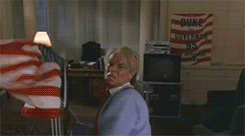 Former Ku Klux Klan member and current politician Duke Metzger angers the local Black community by moving into a former plantation home where the slaves on the property were massacred following the Civil War by the owner who couldn’t stand the thought of them going free. Since then the house had stood empty as a memorial of sorts excepting the rumored presence of dolls containing the souls of the slaves put there to rest and recover by a local and long dead Black woman. While Metzger finds no dolls, he does have the mural of the woman surrounded by her dolls. After the mysterious death of his assistant and finding one of the dolls seemingly following him to several locations, he realizes that he’s also angered the souls of the massacred slaves. Defiant until the end, Metzger makes a grandstand with a shotgun but is eventually overwhelmed by the sheer number of dolls.
Former Ku Klux Klan member and current politician Duke Metzger angers the local Black community by moving into a former plantation home where the slaves on the property were massacred following the Civil War by the owner who couldn’t stand the thought of them going free. Since then the house had stood empty as a memorial of sorts excepting the rumored presence of dolls containing the souls of the slaves put there to rest and recover by a local and long dead Black woman. While Metzger finds no dolls, he does have the mural of the woman surrounded by her dolls. After the mysterious death of his assistant and finding one of the dolls seemingly following him to several locations, he realizes that he’s also angered the souls of the massacred slaves. Defiant until the end, Metzger makes a grandstand with a shotgun but is eventually overwhelmed by the sheer number of dolls.
 Duke Metzger’s attempt at running for political office despite his known virulent racism and ties with white supremacist groups parallels the careers of his namesakes, David Duke and Tom Metzger, who each ran for office in their respective states. His over the top campaign and residence in a home known as a symbol of historical and present violence perpetrated against Black people harken not only to Tom and David’s failed campaigns but the unsettling reality that several known racists have, in fact, held influential political offices in the United States. Perhaps two of most well-known examples are former Senator Strom Thurmond, who served in the Senate for nearly five decades and until his death in 2000 and an avowed segregationist early in his career, and former Governor George Wallace who infamously declared, “Segregation now, segregation tomorrow and segregation forever!”
Duke Metzger’s attempt at running for political office despite his known virulent racism and ties with white supremacist groups parallels the careers of his namesakes, David Duke and Tom Metzger, who each ran for office in their respective states. His over the top campaign and residence in a home known as a symbol of historical and present violence perpetrated against Black people harken not only to Tom and David’s failed campaigns but the unsettling reality that several known racists have, in fact, held influential political offices in the United States. Perhaps two of most well-known examples are former Senator Strom Thurmond, who served in the Senate for nearly five decades and until his death in 2000 and an avowed segregationist early in his career, and former Governor George Wallace who infamously declared, “Segregation now, segregation tomorrow and segregation forever!”
Our Metzger presents himself as being all-American, and he’s not far off base. At the height of the Klan’s power, millions of white Americans counted themselves as members or sympathetic to the Klan, and anti-Black racism and violence can be counted as a centuries-old American tradition. Racism is so structurally embedded in the United States that several Black activists, from DuBois’ contemplations on double consciousness to Malcolm X’s assertions that Black people were not Americans, have debated our place in the United States relative to whites and especially given the state violence perpetrated against us (as previously discussed). The film doesn’t miss a chance to assert their stance when Metzger first smashes the mural of the Black woman keeper of the souls with his flag pole and the mural begins to bleed. Later, as he’s about to die, Metzger literally wraps himself in his flag as if it’s a comforting blanket before its protection is ripped away, and he gets his comeuppance.
“Hard-Core Convert”
The last story centers on Jerome, a young Black prison convict serving several murder sentences. Jerome is offered a chance at rehabilitation. At the facility he firsts meets a white supremacist in a neighboring cell who shares his vision of an upcoming race war and proudly admits to having murdered several Black people. He offers Jerome a chance to become a slave in his new world order if he’ll join the right side, so to speak. Jerome angrily rebuffs him but is visibly shaken when the man asks Jerome the color of the men he murdered. They were Black. Later, Jerome is left in a sensory deprivation chamber where he must confront the souls of all the people he has murdered (again, all Black) and ask for forgiveness. Jerome, again, angrily rebuffs this opportunity. Unfortunately for Jerome, this was not only a chance at rehabilitation but a second chance at life, and he pays with his for refusing to atone for his actions.
This storyline seeks to confront gang related intra-racial violence and homicide among Black people in the United States, particularly gun violence. It’s true that most violent crimes are intra-racial and that most Black people are murdered by other Black people. But, this particular story lost me because of the repeated equivocations of Black intra-racial violence with racist, white supremacist violence and the implied critique of “gangster rap.” The filmmakers don’t stop at Jerome being housed next to a violent, anti-Black murderer. He’s also strapped to a machine (in a huge shout out to Clockwork Orange) and forced to witness photographs of real instances of lynchings and racist, genocidal violence interspersed with scenes of fictional intra-racial gun violence. As he watches this and groans in pain, the Black woman in charge taunts him by asking, “What’s wrong, Jerome? You don’t like seeing Black people get killed? But, isn’t that what you’ve been doing all your life, Jerome?”
The implication seems to be that Black on Black violence is as dangerous to Black lives as racist violence, but never touches on how it’s true for every racial group in the United States that most violent crime is intra-racial. It never touches on the disproportionate number of Black people who experience racialized, state-sanctioned violence. It certainly never touches on how structural, systemic and institutional racism has contributed to gang and drug related violence in Black communities. In those ways, this short fails to attain the level of insightfulness as previous tales, but it’s still deeply unsettling to watch.
After Jerome’s tale the anthology and one of my favorite horror films comes to a close. Tales from the Hood never achieved much critical acclaim, and in fact most people I’ve met, even avowed horror fans, have not heard of the movie. So, I always recommend it to fans who like a little social commentary with their screams. I won’t reveal the ending for those of you interested in watching the film (available on Netflix and YouTube). But, to quote one of my uncles who watched the film with us, Mr. Simms, mortician and storyteller, keeps his promise. The men visiting the funeral home end up “knee deep in the shit.”


Pingback: News & Things: Happy Halloween! | women write about comics